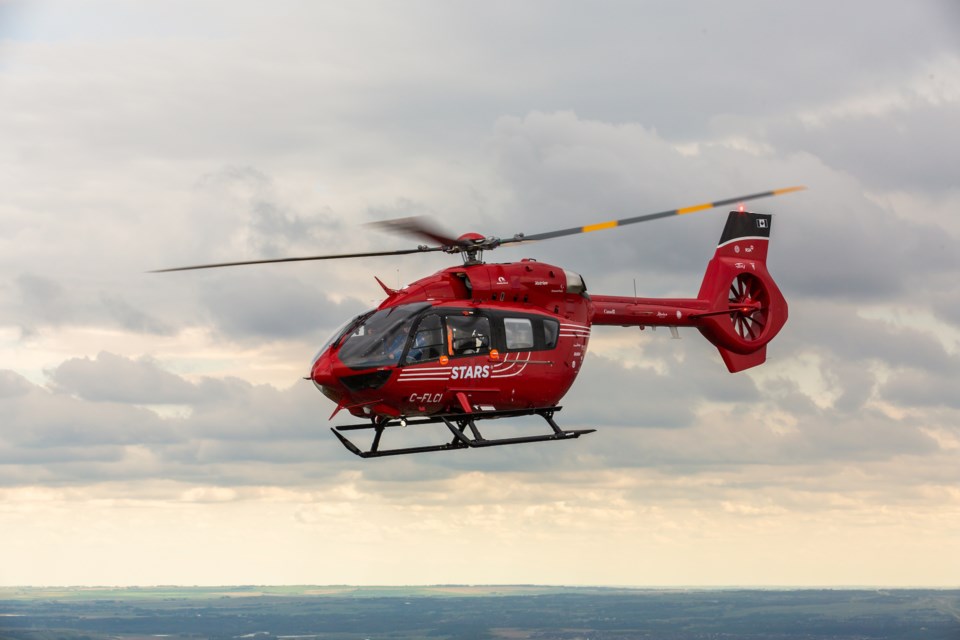ATHABASCA – Shock Trauma Air Rescue Services (STARS) is hoping Athabasca County can help improve air ambulance access in northern Alberta by partnering with the Town of Athabasca to build a heliport in the region.
Glenda Farnden, STARS’ senior municipal relations liaison, was in front of Athabasca County’s council May 30 with a sales pitch — instead of installing a helipad, consider a heliport.
Both facilities cater to helicopters, but Farden said the difference comes down to usage.
“A helipad is any area that is designated as a safe landing area,” said Farnden. "A heliport is an actual facility designed for multiple takeoffs and landings. Oftentimes, it’ll offer a customized range of services, like fire suppression or fuel consumption availability.”
Both Athabasca and Boyle had AHS-certified helipads on municipal land near their respective hospitals, but due to the location — both helipad sites are in the heart of their respective communities and lack bailout sites for pilots — fell into disuse.
Farnden said an H1 heliport would work in those spots precisely because STARS has different requirements than AHS. Only multi-engine helicopters could land at the site, since it doesn’t have an emergency final approach and take off (FATO) within Transport Canada’s limits.
The proposed heliport, which would be located on the opposite side of the hospital from the site Rotary is exploring, would require less infrastructure than an AHS site. STARS pilots don’t require lighting since they fly with night vision googles, and the space doesn’t need to be heated, although it does require a snow removal plan. Rotary’s helipad committee chair was unavailable for comment.
“Through (AHS’s) review, they had their own chosen plan for what they wanted to see for a helipad,” said Farnden. “They wanted to see heating, and lighting, which really isn’t required in the big scheme of things. This is why we had proposed to the town as well as the county to have a look at this other option.”
Costly delays
A designated heliport would be a major boon to STARS, which has flown 472 missions in Athabasca County since 2010—the next highest in the region was Westlock County, where the air ambulance service flew 319 missions. Farnden said the site would significantly reduce transportation time for the STARS crew, who currently rely on ground ambulances for post-landing transportation.
“We’ve had some experiences lately, especially with ground ambulance availability being a real factor, where we’re there and ready to come but there’s no ground ambulance to come and get our crew to get them to the hospital,” said Farnden.
AHS has three main criteria for helipads. Athabasca averages eight inter-facility transfers(IFT) a year, where a patient is moved from one hospital to another, while the province requires 10 in its criteria. While Athabasca is more than the minimum 45 minutes away from tertiary care, the hospital is less than 10 minute drive time from the nearest airport AHS requires for a helipad.
Consistent funding
Premier Danielle Smith announced a renewal of the province’s partnership with the made-in-Alberta air ambulance agency at the organization’s Calgary headquarters June 4, ensuring fast and reliable access to emergency healthcare in the remote regions of the province.
“Every Albertan deserves access to the best-quality healthcare, no matter where they are in our province,” said Smith. “Through STARS, we are better able to connect Albertans in rural and remote communities to critical health care services, improving patient outcomes and providing assurance to families.”
Katherine Emberly, President and CEO at STARS, said the government fundraising was a consistent, stable revenue figure that her organization could plan around, which made their lives a little easier.
“We love this partnership. You’ve got the long-term stability of the government funding, but you also have the community stepping up,” said Emberly. “That allows us to really innovate — when you look in the back of this helicopter, some of the advanced care equipment we’ve been able to do is through our partnership.”
According to the province, the new contract sets new standards for emergency medical response and aims to improve outcomes for patients across the province by stabilizing air ambulance services, including STARS, the Helicopter Air Lift Operation (HALO) in southeast Alberta, and the Helicopter Emergency Response Organization (HERO) out of Fort McMurray.
“In locations with limited road infrastructure, air ambulance operations are critical to support urgent and emergent healthcare needs,” said West Yellowhead MLA Martin Long. “As the parliamentary secretary for rural health and a rural Albertan myself, I have a vested interested in advocating for initiatives that address the healthcare needs of rural and remote communities.”
The 10-year contract will see the province put in $15 million a year, and it expires March 31, 2034.
“We are proud to announce this partnership with STARS, which represents a significant step forward in our ongoing efforts to strengthen emergency medical services in remote and rural areas,” said Health Minister Adriana LaGrange.
“This 10-year contract underscores our commitment to ensuring all Albertans have access to timely and high-quality health care, when and where they need it.”



